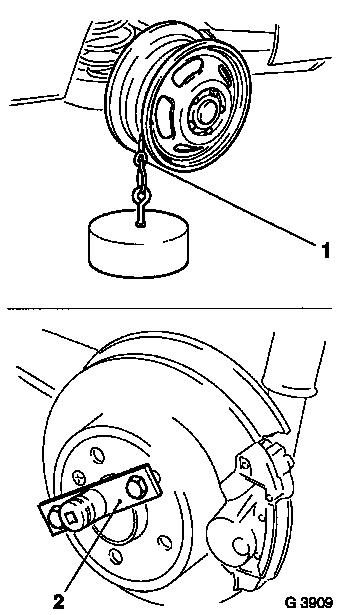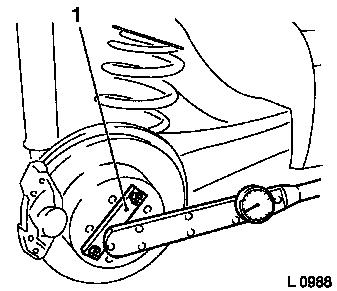|
Locking Value, Check
|
Remove both rear wheels.
 Install
Install
Attach wheel rim to rear wheel hub with Cable KM-252-2-B (1).
Then attach a load of 455 N (corresponds to a weight of approx. 45
kg) to Cable KM-252-2-B.
On the opposite side, fit Driver KM-429-A (2) to rear wheel hub
using two M12 x 1.5 x 40 mm retaining screws.
|

|
|
 Inspect
Inspect
Torque wrench with dial gauge:
Using a torque wrench, turn KM-429-A (1) until the load on the
opposite side ceases to make contact with its support plate. Then
read off the torque applied in Nm on the torque wrench.
Torque wrench with release mechanism:
Turn on KM-429-A with torque wrench set to nominal value until
it cuts out. The load on the opposite side must now no longer touch
the ground. If it lifts too soon or does not lift at all, determine
locking value by increasing/decreasing adjustment value in stages
of 5 Nm / 4 lbf. ft.
|

|
|
The formula for the locking value is as follows:
|
|
|
Mo – Mk
|
|
|
S
|
=
|
-------- x 100 %
|
|
|
|
|
Mo + Mk
|
|
|
|
|
|
|
Where:
|
S
|
=
|
lock value
|
|
|
Mo
|
=
|
Torque in Nm, read off from torque wrench
|
|
|
Mk
|
=
|
Constant torque created by load
|
The following table can be used to determine the locking value
based on the rim diameter. Table for determination of locking
value:
|
14" rim diameter
|
15" rim diameter
|
17" rim diameter
|
|
Torque
|
lock value
|
Torque
|
lock value
|
Torque
|
lock value
|
|
read off
|
|
read off
|
|
read off
|
|
|
in Nm
|
in %
|
in Nm
|
in %
|
in Nm
|
in %
|
|
134
|
25
|
145
|
25
|
164
|
25
|
|
149
|
30
|
160
|
30
|
180
|
30
|
|
167
|
35
|
180
|
35
|
205
|
35
|
|
187
|
40
|
200
|
40
|
230
|
40
|
|
212
|
45
|
230
|
45
|
260
|
45
|
|
241
|
50
|
260
|
50
|
290
|
50
|
|
277
|
55
|
295
|
55
|
335
|
55
|
Note: Limited slip
differentials are functional when the locking value is at least
25%
At less than 25%, an overhaul of the limited slip differential
is required. Quiet noise when slowly driving through tight corners
is not of significance.
This is caused by variations in the friction coefficient at the
plates, partially due to the elasticity of the drive shafts and the
decomposition of additives in the differential fluid.
If the above noise occurs more severely or if the wheels jerk on
the road, the differential fluid must be changed- use only special
fluid in conjunction with fluid additive – see "Technical
Data – Differential Fluid".
The fluid additive must be filled into the rear differential
before the special fluid. If the noise is extremely loud, check the
condition of the molybdenum coating on the limited slip
differential plates and replace if necessary.
|